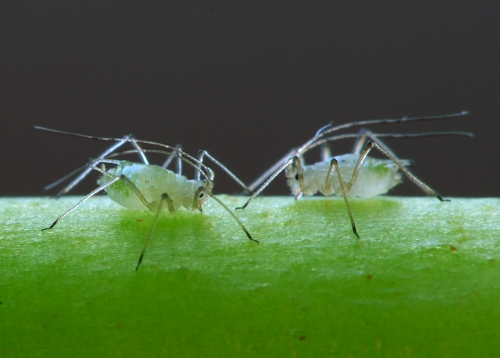
[Courtesy Luc Viatour]
Ugh.
Aphids come in many colors. I’ve seen them in green, gray, black, white, and red. Sometimes they have wings and sometimes they don’t. Despite their changing appearance, aphids always do the same thing: clump on the ends of your plants and slowly suck the life out of them.
I may be jinxing myself by writing this, but I have been gaining control of my aphid problem lately. My garden is changing over the years, and as it does, it is becoming more balanced and the aphids (knock on wood) are less of a problem. Here’s what worked for me:
1. Observe The Aphids. The first step of getting rid of any pest is to observe what is happening in the garden. Are the aphids there on their own or are they being put there by ants that want to feed on the sugary honeydew the aphids secrete? (Read more about the relationship between ants and aphids here.) Are the aphids attacking all the plants or just one kind of plant? How are they getting into the garden? Think of this step as information gathering. If you know what’s going on in the garden, it’s much easier to act.
2. Attract Beneficial Insects. Last year I talked about putting in plants that attract predatory insects in the garden. This really works. My garden is full of insects that were simply not there a few years ago–ladybugs, soldier beetles, predatory wasps, etc. This is the best way to control your aphids because the bugs do it for you. For example, this winter my fava beans had aphids. Before I could react, a bunch of soldier beetles descended and ate the aphids up for me. The downside is that is a slower control method–it took about a year to start seeing results–but you can jump start the process by buying ladybugs in the store and releasing them into your garden.
3. Kill Ants. Often the aphids aren’t really the problem, the ants are. If you have both aphids and ants streaming into your garden, the ants are probably putting the aphids on the plants. If that’s the case, you can remove the aphids all you want but the ants will just put more of them on your plants. Here is a post on how to kill outdoor ants.
4. Spray Aphids Off With Water. If the plant can handle it, spray the aphids off with the hose. Even assuming they could survive, aphids are not smart enough to regroup and go back on your plant. This works great for established plants, but won’t work for seedlings or more delicate plants that will bruise from the water.
5. Use A Gentle Insecticide Soap. Finally, I preemptively spray areas that I know are vulnerable to aphids with insecticide soap. In particular, I always spray the new growth on my squash plants, which is apparently an aphid paradise. Use insecticide soap that says you can use “up to the day of harvest” and doesn’t harm bees. Or make your own.
That’s my method. How do you control aphids?

I battled this for years!!! I love your blog.. just stumbled across it.
Hope you don’t mind.. I just posted my solution to aphids and cutworms on my blog at http://www.ThumperLane.com .
What totally works for me is just putting a few drops of Dawn or any other dishwashing soap into a spray bottle with water and just misting my roses where I see them. Within a few days the aphids all turn black and die. The bonus is that it’s safe to use on vegetable plants!